Aspen Gall - Leaf Vase formed by Pemphigus Aphids
Thoughts upon examining a very cool gall in Northern Arizona.
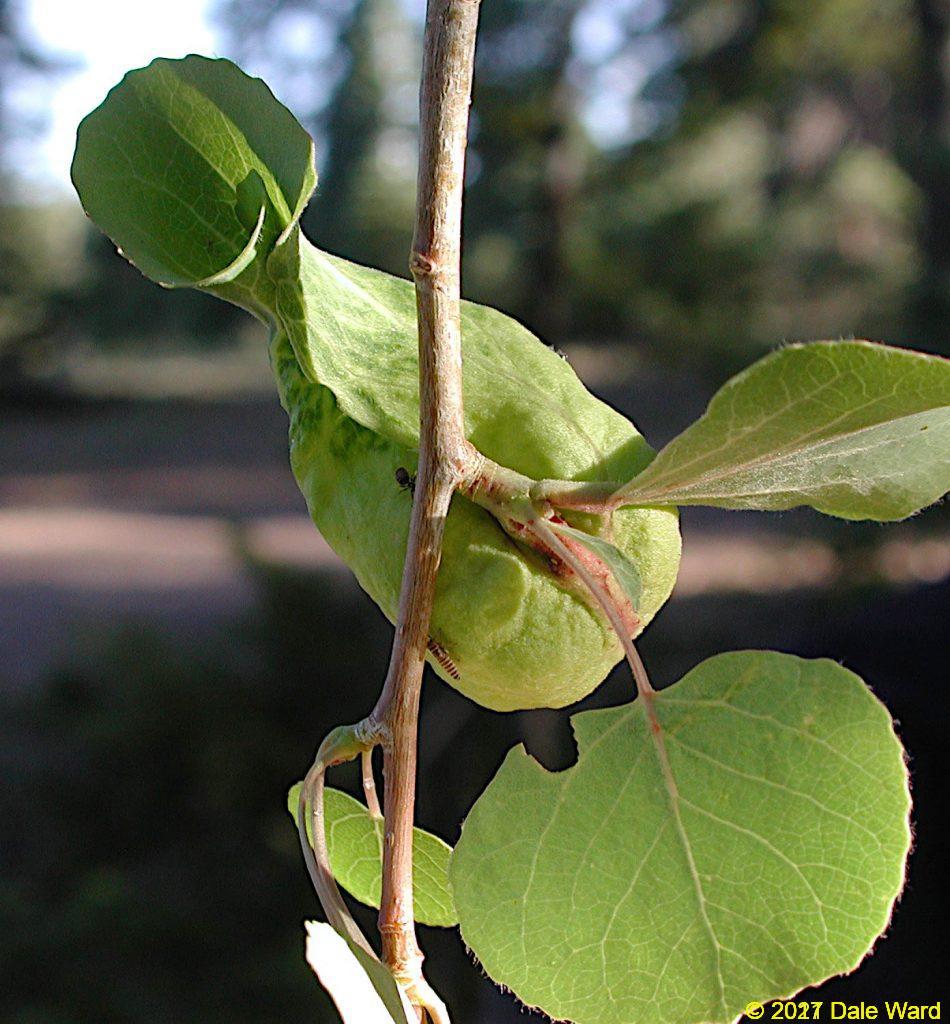 Quaking Aspen twig with leaf gall. The vase-shaped gall seems to be a single leaf that has warped and wrapped around itself. You can see one of the ants, near the twig.
Quaking Aspen twig with leaf gall. The vase-shaped gall seems to be a single leaf that has warped and wrapped around itself. You can see one of the ants, near the twig.
One evening in June of 2001, Laurie and I were camping on the East Overlook of the North Kaibab National Forest. We’d just set up camp after a long drive. While we were walking around, waiting for the sun to set, we noticed a very strange object hanging off of a Quaking Aspen twig.
It was a perfectly formed vase, about an inch and a half long. There were ants (Tapinoma sessile) crawling in and out of the vase.
Hmm. Well. I never. What on earth was this?
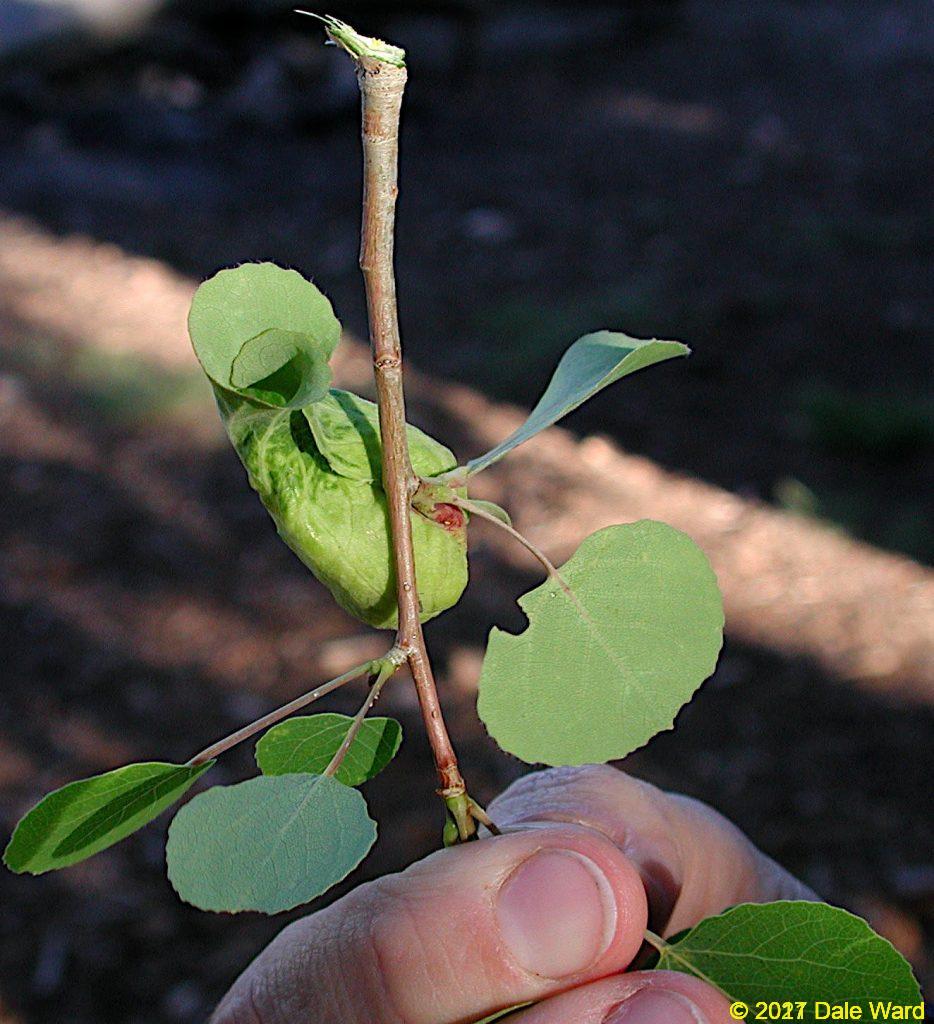 Photo of Quaking Aspen twig with gall, held in fingers for scale’
Photo of Quaking Aspen twig with gall, held in fingers for scale’
I broke the branch off of the tree, and tried to look at it more closely. It seemed to have been made out of a single leaf. As I looked at it, I accidentally ripped the vase open - the leaf was thickened, and not as flexible as the leaves usually are.
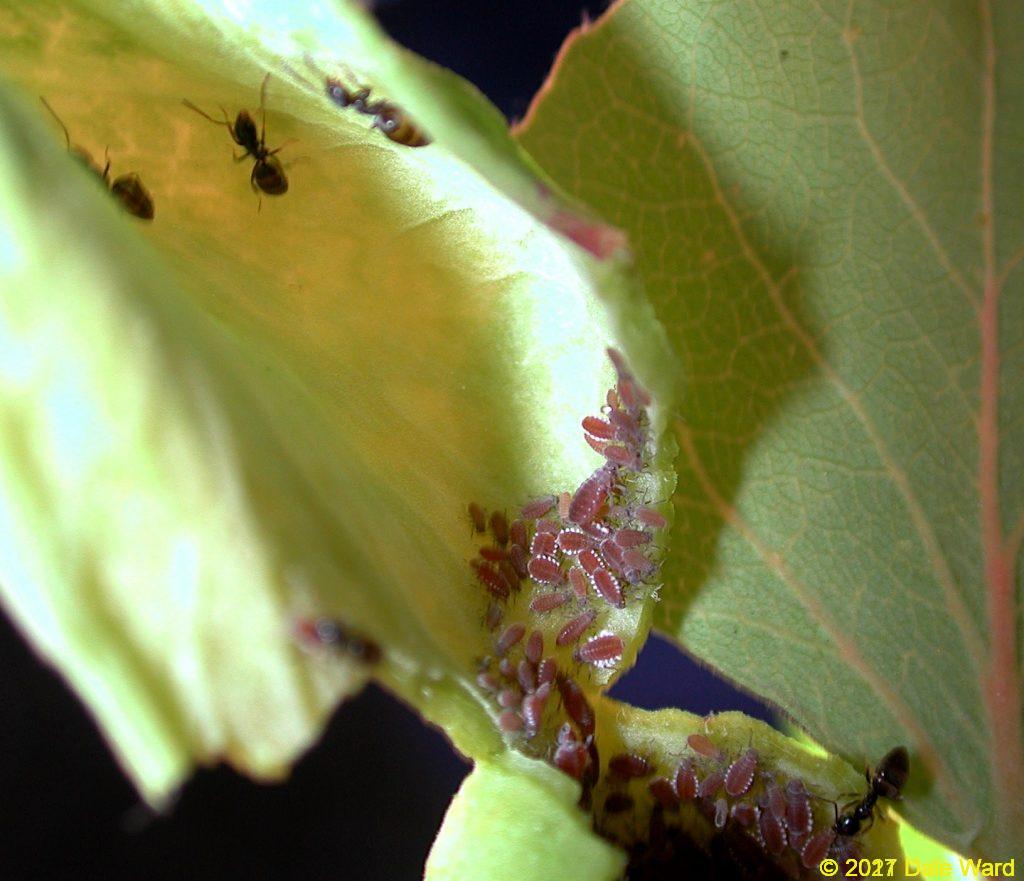 Aphids in the bottom of the leaf “vase”. You can see the ants in the upper left of the photo.
Aphids in the bottom of the leaf “vase”. You can see the ants in the upper left of the photo.
There were lots of aphids in the ‘bowl’ of the vase. They were reddish-purple in color, and some of them had a line of fluffy white tufts running down their sides.
Tucked away in the portion of the vase that connected to the twig, there was a strange object. It looked like a button.
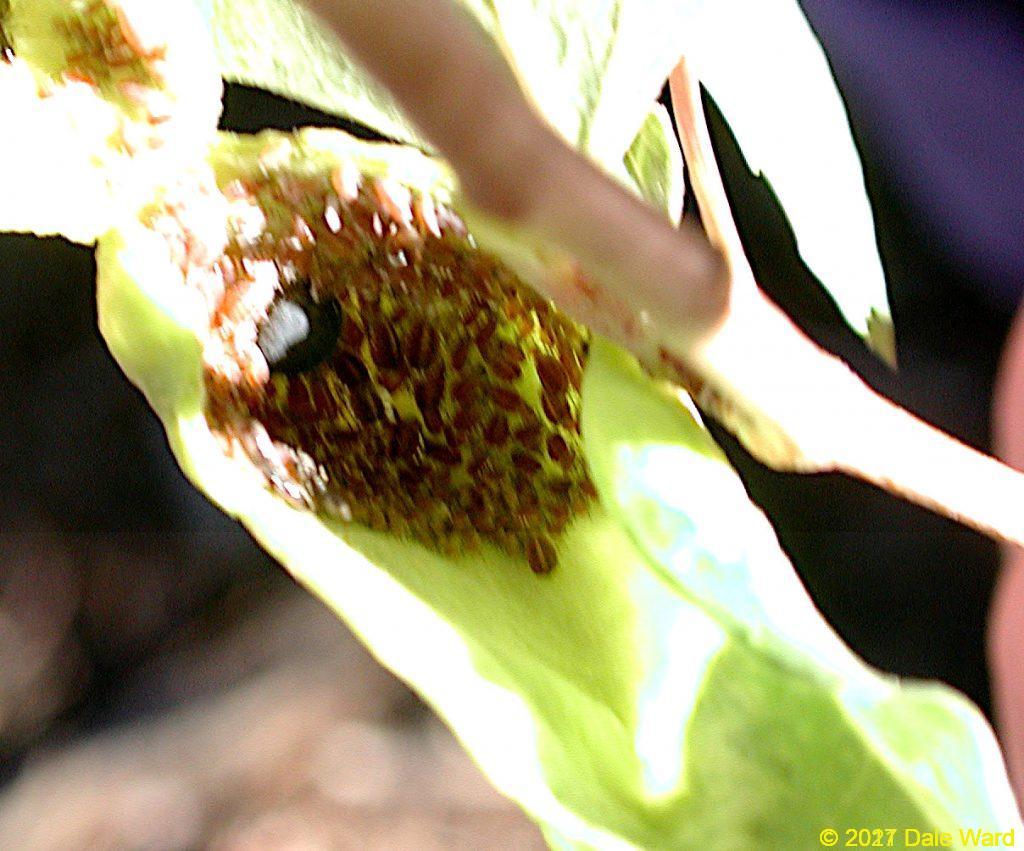 Argh! Very blurry photo of the inside of the vase-shaped gall. You can see the fundatix - the ‘stem mother’ of the gall - she’s the black dot surrounded by her smaller offspring.
Argh! Very blurry photo of the inside of the vase-shaped gall. You can see the fundatix - the ‘stem mother’ of the gall - she’s the black dot surrounded by her smaller offspring.
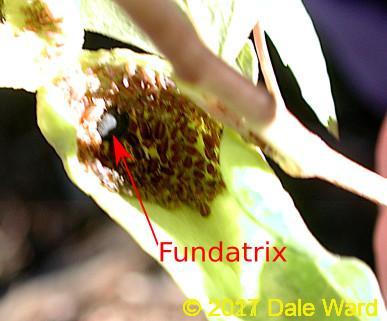 Another view of the interior of the vase-shaped gall, this time with the fundatrix labeled.
Another view of the interior of the vase-shaped gall, this time with the fundatrix labeled.
The “button bug” was an insect of some kind. I had no idea what type of insect, though. In those days, I preserved a lot of insects specimens, and I popped it into a vial of alcohol for later examination.
The vase was a gall of some sort. But this gall was astonishing. I’ve not seen another so ornate.
When I got home, I looked at the ‘button’ insect again. It looked like a strange, distorted aphid. I poked around on through my books and on the internet, and came up with a tentative genus on the aphid. I think that the “button bug”, and all of the smaller aphids, were aphids in the genus “Pemphigus”.
None of the aphids I read about create vase-like galls such as this one, but there are a lot of Pemphigus aphids that create galls in the petioles of Aspens. My suspicion is that these aphids are related to Pemphigus spyrothecae - the Poplar Spiral Gall Aphid.
If I’m correct, then the “button bug’ was a a form of aphid called a “fundatrix”. One really cannot make some of this terminology up.
The smaller, “normal” looking, aphids, were all offspring of the fundatrix.
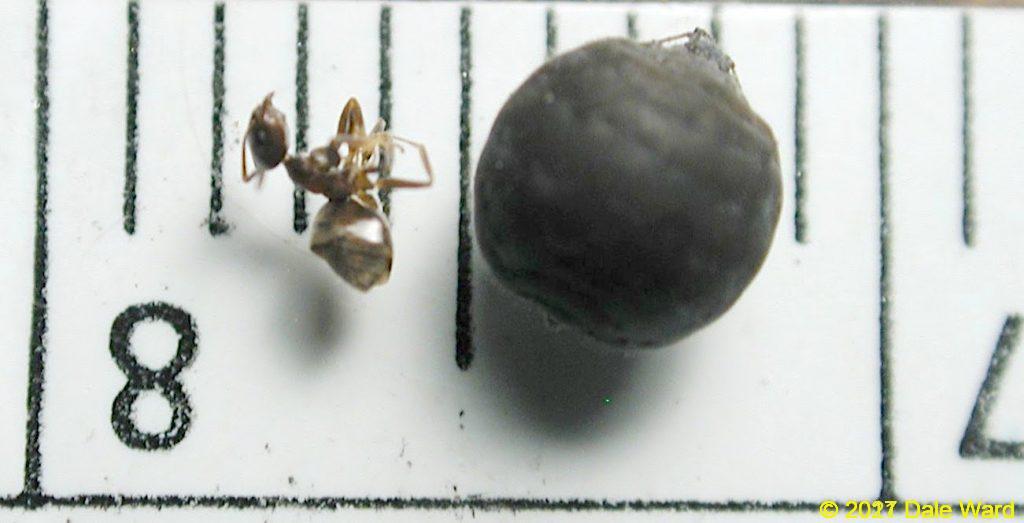 Fundatrix on a ruler scale. Each division of the rule is 1mm. Her head is pointing to the upper right - you can just see her antennae. The ant in the photo is not from the gall.
Fundatrix on a ruler scale. Each division of the rule is 1mm. Her head is pointing to the upper right - you can just see her antennae. The ant in the photo is not from the gall.
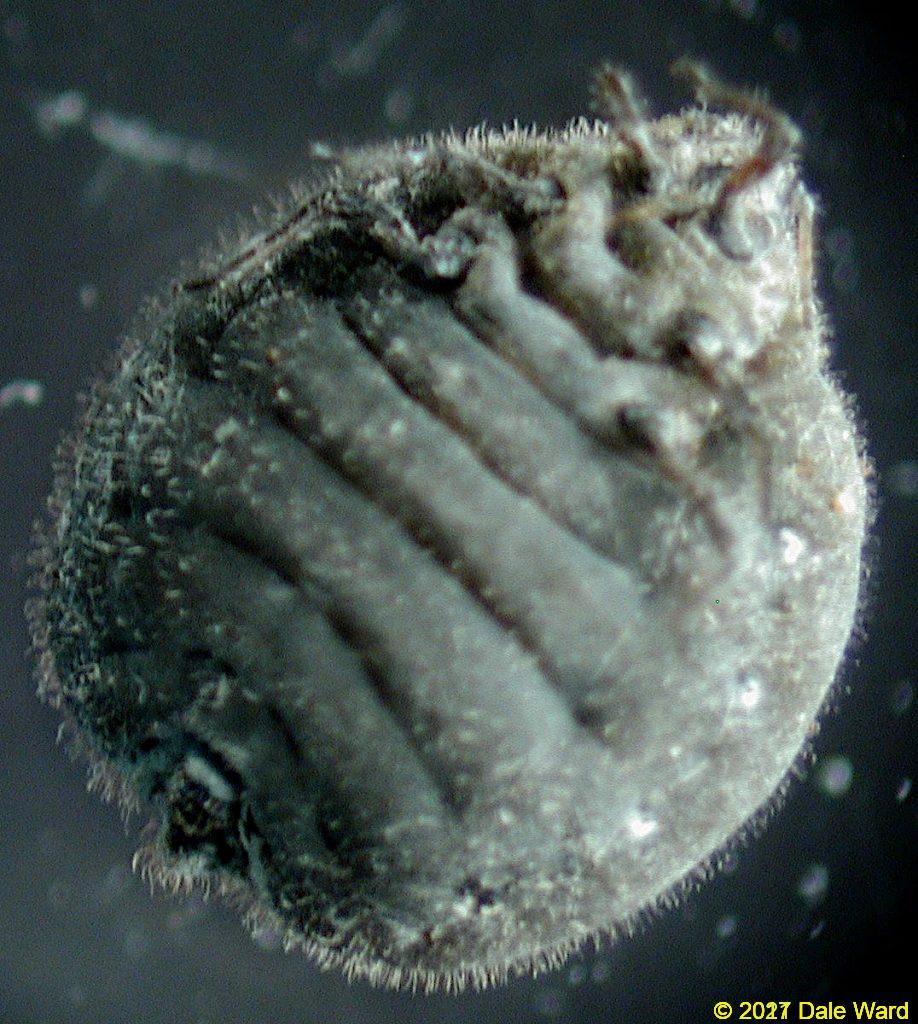 Ventral view of the fundatrix. Her head and legs are in the upper-right corner of the photo.
Ventral view of the fundatrix. Her head and legs are in the upper-right corner of the photo.
The leafy vase was a gall - plant tissue whose growth has been taken over by aphids or some other organism. After that take-over happens, the plant tissue now grows for the benefit of the aphid, not necessarily for the plant itself. The aphid essentially says, “Hey Plant, grow me a house that looks like this.”, and the plant does it.
The insects live inside the gall, and the gall protects the insects from parasites and predators. The aphids feed on the plant’s phloem, which is sort of like the “blood” of the plant. Phloem is a liquid that is loaded with sugars - the products of the plants photosynthesis.
To get all of the nutrients they need, the aphids need to drink a lot of phloem. The phloem contains more liquids and sugars than the aphids can assimilate, and they excrete the sugar-rich excess liquid as droplets of “honeydew”.
Free-living sap-feeding insects have a few different ways that they can manage this sugary waste. One way is to squirt the liquids out under pressure, to just eject droplets the waste off into the air. These droplets land on whatever is nearby and dry, sometimes accumulating in layers. The “manna from heaven” that the Israelites feasted upon? Some people suggest that it was honeydew excreted by insects feasting on Tamarisk Trees.
Another way for sap-feeding insects to handle the sugar-rich waste is to feed have other insects do the work of carrying it away. The liquid waste is full of sugars, after all - it’s only waste as far as the aphids are concerned.
Ants, for example, love “honeydew”. The ants come to rely on the honeydew as a major food source. The ants will even treat the honey-dew producers in a manner similar to how humans farm cattle. The ants guard the aphids from predators, move them from one good feeding site to another.
This ant/honeydew-producing insect relationship is a widespread and common relationship. Below are a couple of photos illustrating it in other instances.
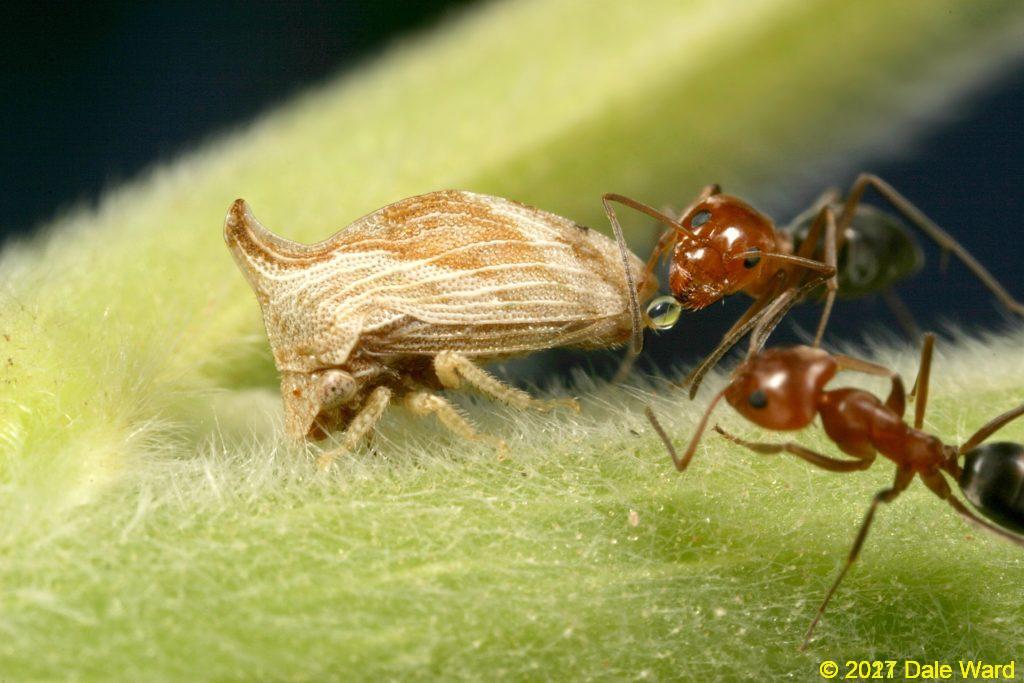 Ants (Dorymyrmex bicolor) taking taking droplet of honeydew from Membracid Treehopper (related to aphids)
Ants (Dorymyrmex bicolor) taking taking droplet of honeydew from Membracid Treehopper (related to aphids)
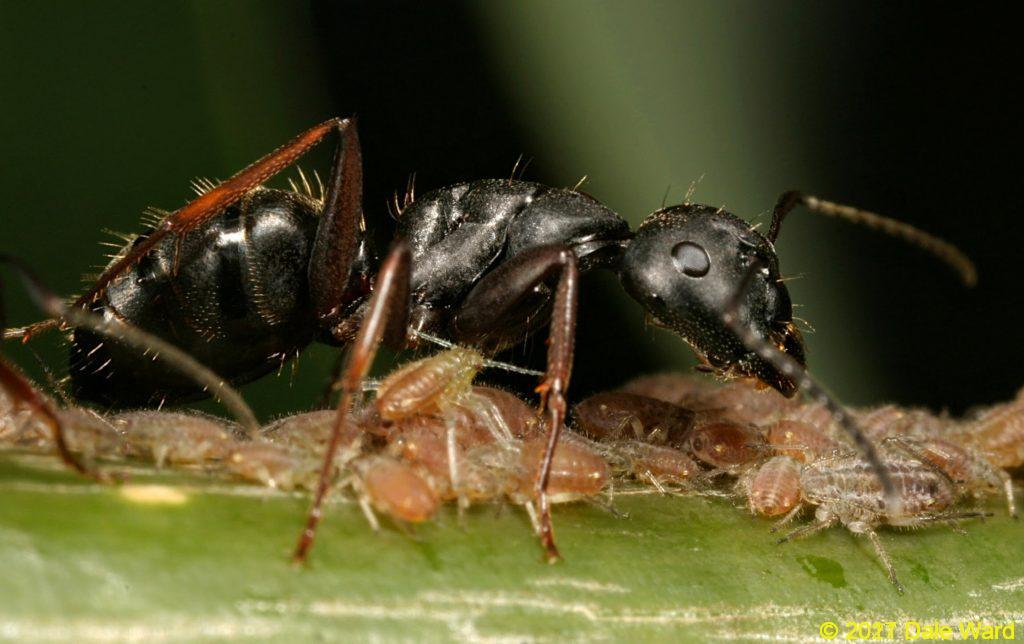 Camponotus mina, a Carpenter Ant, farming aphids.
Camponotus mina, a Carpenter Ant, farming aphids.
The aphids I found were living in a mostly closed gall - there was a relatively small opening at the top. This gave ants the ability to come in and clean up the honeydew, which they were doing when we found the gall.
Another approach that aphids can take to get rid of honeydew, especially in enclosed spaces such as a gall, is to coat the droplets of honeydew with wax.
That white, cottony like substance on the sides of the small aphids is a type of wax. The wax gets everywhere inside the call, coating the aphids, the gall walls. The honey-dew droplets even get coated in the wax, forming tiny liquid-filled wax marbles. This serves to keep the waste honey-dew off of the aphids.
As if this weren’t weird enough, some aphids modify the plant tissue inside the gall so that it re-adsorbs the liquid honeydew.
So - what is the relationship of the fundatrix to the smaller aphids?
The fundatrix hatched from a fertilized egg early in the year, and formed the gall. She produced the smaller aphids via parthenogenesis - virgin birth.
Some species of aphids are actually primitively social insects, and these offspring will vary morphologically and behaviorally. They have thick-legged soldiers that will rush to the defense of the gall, other aphids that specialize in carrying out the wax balls of honey-dew waste, etc.
It blew me away when I read that. I had never even considered that aphids might have some sort of social structure. I am kicking myself for not examining the smaller aphids more closely. Pemphigus is one of the genera that display this social organization, and I would not be surprised to have seen it in this gall.
As to what happens with the rest of the aphid life cycle - how the fundatrix got into the gall, how and when the winged sexual forms of the aphids are produced - I don’t know for sure. There are a lot of variations on aphid life-cycles.
The aphids may switch to different entirely different plant hosts and form another gall during other parts of their life cycle, for example.
So the cycle below is a dramatic oversimplification. But most of the life cycles seem to be a variation on:
-
Sexually produced eggs over-Winter, hatch into a fundatrix
-
Fundatrix asexually produces wingless forms
-
Wingless forms asexually produce winged sexual forms - males and females
-
Winged sexual forms mate and lay eggs
And those eggs overwinter, and hatch into a new fundatrix.
This gall was astonishing, I’ve not seen another as ornate.
Sources:
Borror, Donald J, Charles A. Triplehorn, Norman F. Johnson, 1988. An Introduction to the Study of Insects.. Philadelphia: Saunders College Publications.
Charney, Noah and Charley Eiseman. 2010. Tracks & Signs of Insects and Other Invertebrates. Stackpole Books; 1st edition.
Influential Points’ Pemphigus aphid page: A marvelous website containing information about aphids’
Kutsukake M, Uematsu K and Fukatsu T (2019) Plant Manipulation by Gall-Forming Social Aphids for Waste Management. Front. Plant Sci. 10:933. doi: 10.3389/fpls.2019.00933